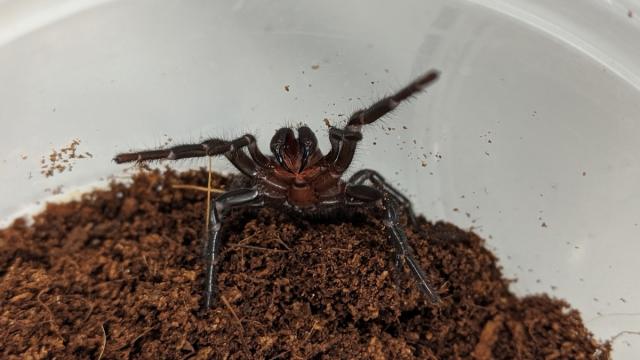Funnel web spiders are known for their menacing presence in Australian homes but footage published by an Australian PhD student shows the deadly spider at its most vulnerable ” shedding its outer layer, or exoskeleton.
Samantha Nixon, a PhD student at the University of Queensland, posted the video on Twitter, noting it was the first time she’d seen it happen in her five years of studying spiders.
I’ve worked on spiders ~5 years & this is the 1st time I’ve caught one moulting! Sydney funnelweb spider (Atrax robustus) shedding his exoskeleton to grow! This is normally the deadliest spider in the world – but right now he’s totally vulnerable until his exoskeleton hardens. pic.twitter.com/LY7m8o6CRW
— Samantha Nixon (@SamNScience) April 5, 2020
The funnel web spider in the video is called Harry, also known as number 58, and Nixon told Gizmodo Australia the process is an exhausting but a necessary step Harry will need to take in order to grow any bigger.
“Spiders have muscles that allow their legs to flex, but not to extend. They have to increase their heart rate to pump their haemolymph ” the equivalent of blood ” into their cephalothorax so that it expands and cracks their old exoskeleton. Then they can break through the top of their old skeleton ” basically through the top of what looks like the head,” Nixon told Gizmodo Australia over email.
“Then they flex their legs to push themselves free. Their new exoskeleton is soft and folded up a little bit which enables them to now grow bigger.”
That exoskeleton, which is essential for the spider’s protection, then lasts until the next time it needs to be shed.
“This is a hard protective covering for the spider with some bendy joints that allow the spider to move,” Nixon said. That exoskeleton is made up of cuticles, which are in turn composed of proteins and chitin to make a very strong outer shell but this presents a problem for spiders as they grow.
“The downside is that it becomes inflexible ” the spider can’t grow bigger. So they have to shed their exoskeleton in order to grow. The shedding process is called moulting.”
During this process, the funnel web is completely vulnerable. In the wild, the spider lives in burrows so it would be hidden from the view of predators but in laboratories, special precautions need to be taken to ensure its livelihood isn’t threatened.
“They need energy and water because it is a very energetically expensive process but because they are so soft and relatively defenseless, if you’re not careful sometimes the prey ” crickets ” eat the spiders,” Nixon said to Gizmodo Australia.
“You have to be very, very careful feeding the spiders around moulting.”
The process lasts anywhere between a few hours and a few days and Nixon said she’s noted the spiders come out white once it’s done before changing to a “bluish-black with a metallic blue sheen” and finally the image we’ve all seen before ” a glossy black colour.
It’s a reminder these creatures, while frightening to some, are just as vulnerable as the rest of us.
[referenced url=”https://gizmodo.com.au/2019/12/newly-discovered-widow-spider-lays-bright-purple-eggs/” thumb=”https://i.kinja-img.com/gawker-media/image/upload/t_ku-large/asmdfvos83lvqqggnvhm.jpg” title=”Newly Discovered Widow Spider Lays Bright Purple Eggs” excerpt=”Scientists have discovered a spider living in South Africa that’s truly a sight to behold. The arachnids feature a scarlet, exclamation mark-shaped blotch on their backs, along with a white squiggle pattern that creates the vague shape of a human face, mouth agape in horror.”]
